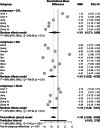The effect of vitamin D status on the occurrence of Kawasaki Disease: a meta-analysis
- PMID: 38684993
- PMCID: PMC11057174
- DOI: 10.1186/s12887-024-04768-1
The effect of vitamin D status on the occurrence of Kawasaki Disease: a meta-analysis
Abstract
Aim: The relationship between vitamin D status and Kawasaki Disease (KD), as well as coronary artery lesion (CAL), has yet to be established.
Methods: A meta-analysis was conducted to assess the correlation between vitamin D status and KD, as well as the impact of vitamin D status on the progression of KD into CAL.
Results: The meta-analysis revealed a consistent and significant association between serum 25(OH)D level and the occurrence KD (studies N = 22; z = -3.51, P < 0.001). Patients with KD had markedly lower levels of vitamin D than healthy controls (SMD: -1.30 ng/mL, 95%CI: -2.05 to -0.55 ng/mL).
Conclusion: The study provided evidence supporting a significant association between lower serum vitamin D levels and the occurrence of KD, particularly within the Chinese population. However, the findings did not suggest a direct impact of vitamin D on the development of CAL in KD patients.
Keywords: 25-hydroxyvitamin D; Coronary artery lesion; Kawasaki disease; Vitamin D.
© 2024. The Author(s).
Conflict of interest statement
The authors declare no competing interests.
Figures


Similar articles
-
Severe vitamin D deficiency in patients with Kawasaki disease: a potential role in the risk to develop heart vascular abnormalities?Clin Rheumatol. 2016 Jul;35(7):1865-72. doi: 10.1007/s10067-015-2970-6. Epub 2015 May 22. Clin Rheumatol. 2016. PMID: 25994612
-
The impact of vitamin D on the onset and progress of Kawasaki disease.Pediatr Int. 2022 Jan;64(1):e15191. doi: 10.1111/ped.15191. Pediatr Int. 2022. PMID: 35831250
-
Investigating the comparative effect of vitamin D level with the type of complications in Henoch Schönlein purpura and Kawasaki disease.Reumatol Clin (Engl Ed). 2024 Apr;20(4):199-203. doi: 10.1016/j.reumae.2024.04.004. Reumatol Clin (Engl Ed). 2024. PMID: 38644031
-
[Research advances in association between vitamin D and Kawasaki disease and related mechanisms of action].Zhongguo Dang Dai Er Ke Za Zhi. 2016 Dec;18(12):1319-1323. doi: 10.7499/j.issn.1008-8830.2016.12.024. Zhongguo Dang Dai Er Ke Za Zhi. 2016. PMID: 27974130 Free PMC article. Review. Chinese.
-
Association between circulating 25-hydroxyvitamin D and systemic lupus erythematosus: A systematic review and meta-analysis.Int J Rheum Dis. 2019 Oct;22(10):1803-1813. doi: 10.1111/1756-185X.13676. Epub 2019 Aug 30. Int J Rheum Dis. 2019. PMID: 31468723
References
-
- Kawasaki T. Acute febrile mucocutaneous syndrome with lymphoid involvement with specific desquamation of the fingers and toes in children. Arerugi. 1967;16(3):178–222. - PubMed
-
- Huang GY. Challenges in the diagnosis and treatment of Kawasaki disease. Zhonghua Er Ke Za Zhi. 2022;60(1):3–5. - PubMed
-
- Correction to: Diagnosis, Treatment, and Long-Term Management of Kawasaki Disease: A Scientific Statement for Health Professionals From the American Heart Association. Circulation, 2019. 140(5):e181–e184. - PubMed
Publication types
MeSH terms
Substances
LinkOut - more resources
Full Text Sources
Medical

